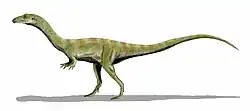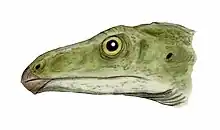| Shuvosaurus | |
|---|---|
 | |
| Restoration | |
| Scientific classification | |
| Domain: | Eukaryota |
| Kingdom: | Animalia |
| Phylum: | Chordata |
| Class: | Reptilia |
| Clade: | Archosauria |
| Clade: | Pseudosuchia |
| Clade: | Paracrocodylomorpha |
| Superfamily: | †Poposauroidea |
| Family: | †Shuvosauridae |
| Genus: | †Shuvosaurus |
| Species: | †S. inexpectatus |
| Binomial name | |
| †Shuvosaurus inexpectatus | |
| Synonyms | |
| |
Shuvosaurus (meaning "Shuvo's lizard") is a genus of beaked reptile from the Late Triassic of western Texas. Despite looking superficially similar to a theropod dinosaur, it is actually more closely related to crocodilians.
Discovery and classification

Shuvosaurus was described by Sankar Chatterjee in 1993 after it was discovered by his son Shuvo in the early 1990s.[1][2] It was initially interpreted as a Triassic member of the Cretaceous dinosaur family Ornithomimidae because it had toothless jaws. Like the avian placement of Protoavis, the ornithomimosaur placement of Shuvosaurus was greeted with scepticism by others, and in their 1995 monograph on Late Triassic tetrapods from the American Southwest, Robert Long and Philip Murry considered Shuvosaurus to be possibly the same species as their new taxon Chatterjeea, which was based on 10 postcranial skeletons that had been previously referred to the rauisuchid Postosuchus by Chatterjee (1985), noting that the Shuvosaurus and the Chatterjeea material didn't overlap in terms of available material.[3] For his part, Rauhut (1997, 2000, 2003) agreed with Long and Murry (1995) in questioning the ornithomimosaur placement of Shuvosaurus but classified it as a basal theropod.[4][5][6]
In the early 2000s, Sterling Nesbitt and Mark Norell prepared previously unopened jackets of an archosaur from the Whitaker Quarry at Ghost Ranch, which they named Effigia in 2006. This discovery showed that Shuvosaurus is more closely related to crocodilians, and that similarities between this animal and ornithomimids result from convergent evolution, while demonstrated that the taxon Chatterjeea was synonymous with Shuvosaurus.[7][8]
Shuvosaurus in a cladogram after Butler et al., 2011:[9]
| Poposauroidea |
| ||||||||||||||||||||||||||||||||||||||||||||||||||||||||||||
References
- ↑ Chatterjee, S. (1991) An unusual toothless archosaur from the Triassic of Texas: the world's oldest ostrich dinosaur? Abstract, Journal of Vertebrate Paleontology, 8(3): 11A.
- ↑ Chatterjee, S. (1993). "Shuvosaurus, a new theropod: an unusual theropod dinosaur from the Triassic of Texas". National Geographic Research and Exploration. 9 (3): 274–285.
- ↑ Long and Murry, 1995. Late Triassic (Carnian and Norian) tetrapods from the Southwestern United States. Bulletin of the New Mexico Museum of Natural History and Science. 4, 1-254.
- ↑ Rauhut, O. W. M. (1997). "On the cranial anatomy of Shuvosaurus inexpectatus (Dinosauria: Theropoda)." In: Sachs, S., Rauhut, O. W. M. & Weigert, A. (eds) 1. Treffen der deutschsprachigen Palaeoherpetologen, Düsseldorf, 21.-23.02.1997; Extended Abstracts. Terra Nostra 7/97, pp. 17-21.
- ↑ Rauhut, 2000. The interrelationships and evolution of basal theropods (Dinosauria, Saurischia). PhD thesis, University of Bristol. 440 pp.
- ↑ Rauhut, 2003. The interrelationships and evolution of basal theropod dinosaurs. Special Papers in Palaeontology. 69, 96 pp.
- ↑ Nesbitt, Sterling J.; Norell, Mark A. (2006). "Extreme convergence in the body plans of an early suchian (Archosauria) and ornithomimid dinosaurs (Theropoda)". Proceedings of the Royal Society B: Biological Sciences. 273 (1590): 1045–1048. doi:10.1098/rspb.2005.3426. PMC 1560254. PMID 16600879.
- ↑ Nesbitt, S. (2007). "The anatomy of Effigia okeeffeae (Archosauria, Suchia), theropod-like convergence, and the distribution of related taxa." Bulletin of the American Museum of Natural History, 302: 84 pp.
- ↑ Butler, R.J.; Brusatte, S.J.; Reich, M.; Nesbitt, S.J.; Schoch, R.R.; Hornung, J.J. (2011). Andrew A. Farke (ed.). "The Sail-Backed Reptile Ctenosauriscus from the Latest Early Triassic of Germany and the Timing and Biogeography of the Early Archosaur Radiation". PLOS ONE. 6 (10): e25693. Bibcode:2011PLoSO...625693B. doi:10.1371/journal.pone.0025693. PMC 3194824. PMID 22022431.
